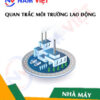Occupational Environment Monitoring of an Ethanol Manufacturing Factory
99,000 ₫
Note: The above price is calculated for one sample, prices may fluctuate depending on the area of the environment to be monitored and market movements. For more accurate price support, please refer to the price list or contact our consulting staff directly.
Monitoring the environment of an ethanol manufacturing factory is a session of collecting, analyzing, and evaluating factors at the workplace that may be harmful to workers’ health.
Table of Contents
Toggle1. Overview of the ethanol production factory
a. What is an ethanol production factory?
Factory producing ethanol is an industrial facility where ethanol, an organic compound widely used in various industries and applications, is manufactured. Ethanol, also known as ethyl alcohol, is a type of alcohol containing ethyl molecules (C2H5OH). It is produced through fermentation of starch, sugar, cellulose, or other biological resources.
Ethanol factories typically use processes and technologies such as fermentation, distillation, and refinement to produce high-concentration ethanol. The production process includes stages such as raw material preparation, crushing, primary fermentation, secondary fermentation, distillation, refinement, and quality control procedures.
Ethanol has various applications, including use in biofuel production, manufacturing of cleaning agents, cosmetics, pharmaceuticals, and the food industry. Additionally, it is used in medical applications and as a solvent in consumer products.

b. Production stages in the ethanol production factory
The production stages of ethanol in the factory may include the following:
- Raw material preparation: The main raw materials used for ethanol production are starch, sugar, cellulose, or other biological resources. Raw materials are inspected and prepared before entering the production process.
- Crushing: Raw materials are crushed to increase surface area and improve contact with fermentation enzymes.
- Fermentation: Crushed raw materials are mixed with enzymes to initiate the fermentation process. Enzymes help convert starch or sugar into glucose and then into ethanol.
- Secondary fermentation (if needed): In some cases, after the initial fermentation stage, secondary fermentation is carried out to continue converting glucose into ethanol.
- Distillation: After fermentation is complete, the mixture is distilled to separate ethanol from other components. Distillation uses temperature and pressure to achieve separation between ethanol and other substances.
- Refinement: After distillation, ethanol may undergo refinement to remove remaining impurities. This process includes methods such as absorption, neutralization, or other techniques to purify ethanol.
- Quality control procedures: Throughout the production process, quality control procedures are performed to ensure ethanol meets the required quality standards.

c. Machinery used in the ethanol production factory
In an ethanol production factory, various machines and equipment are used to perform production processes. Some common machines in ethanol production include:
- Crusher: Used to crush raw materials such as starch, sugar, or cellulose to increase surface area and improve contact with fermentation enzymes.
- Fermentation tank: Where fermentation occurs, mixing raw materials with enzymes to convert them into glucose and then ethanol.
- Mixer: Used to combine crushed raw materials and enzymes during fermentation.
- Secondary fermentation tank: Used if secondary fermentation is required to further convert glucose into ethanol.
- Distillation equipment: Includes distillation columns, multi-tube distillation systems, or distillation tanks, used to separate ethanol from other components.
- Refinement equipment: Includes filters, absorption systems, neutralization, or other refining methods to remove impurities and purify ethanol.
- Measurement and control devices: Includes temperature sensors, pressure sensors, automated control systems, and process control devices to ensure production follows the correct procedures and achieves the desired quality.
- Storage and transport tanks: Includes storage tanks and pipelines to store and transport ethanol from production to use or temporary storage.

d. Occupational diseases that may occur for workers in the ethanol production factory
Workers in the ethanol production factory may be exposed to some occupational diseases due to environmental factors and ethanol production processes. Common occupational diseases include:
- Respiratory diseases: Workers in environments with high alcohol vapor and organic vapors may suffer from respiratory issues such as bronchitis, pneumonia, dry cough, difficulty breathing, and impaired respiratory function.
- Skin diseases: Exposure to ethanol and other chemicals during production may cause skin irritation, dermatitis, and eczema.
- Eye diseases: Exposure to alcohol vapor and chemicals may cause eye irritation and damage, including conjunctivitis, redness, and vision problems.
- Liver and kidney diseases: Exposure to toxic chemicals may negatively impact liver and kidney function.
- Digestive diseases: Contact with ethanol and chemicals can irritate the stomach and intestines, causing nausea, abdominal pain, and digestive disorders.
- Nervous system diseases: Workers may be affected by alcohol vapor and other chemical compounds, leading to neurological issues such as dizziness, memory loss, neurological disorders, and discomfort.
- Cardiovascular diseases: Exposure to alcohol vapor and chemicals may negatively affect the cardiovascular system, increasing the risk of hypertension and heart disease.

e. Common types of ethanol on the market
Ethanol is widely used in various fields. Some common types include:
- Medical ethanol: Used in healthcare as a disinfectant and cleanser on the skin before injections, and for cleaning medical instruments and surfaces in healthcare facilities.
- Industrial ethanol: Used in industrial processes as a solvent in chemical production, ink production, cleaning agents, and synthetic resins.
- Food-grade ethanol: Used in the food industry, food packaging, and beverage production. It can extract substances from food ingredients and enhance texture and flavor.
- Fuel ethanol: Used as an alternative energy source to gasoline in biofuel applications. Fuel ethanol can be used in cars, motorcycles, generators, and other energy applications.
- Cleaning ethanol: High-concentration ethanol used for cleaning and disinfecting surfaces and equipment effectively.

2. Overview of occupational environment monitoring services
a. What is occupational environment monitoring at ethanol production factories?
Occupational environment monitoring (or workplace environment measurement) at ethanol production factories involves collecting, evaluating, and analyzing measurements of workplace environmental factors to implement timely measures, minimize environmental impacts on worker health, and prevent occupational diseases. Occupational environment monitoring is mandatory for ethanol production factories.
This monitoring is crucial for protecting and enhancing worker health, as workers are the main resource of enterprises and directly generate profits. Workers frequently exposed to hazardous or harmful factors exceeding allowable limits may suffer health issues and occupational diseases.
REGISTER FOR OCCUPATIONAL ENVIRONMENT MONITORING SERVICE
b. Nam Viet’s occupational environment monitoring program
Nam Viet’s occupational environment monitoring program is designed by engineers specialized in occupational safety and environmental protection. To ensure worker health and safety, the program uses modern measurement methods to monitor air quality, water, microclimate factors, physical conditions, dust, and more in the workplace. This program is vital for maintaining a safe working environment and protecting worker health.
Additionally, Nam Viet’s program plays an important role in researching and developing solutions to improve workplace environmental quality. With the dedication and professionalism of its monitoring experts, Nam Viet’s exclusive program represents a breakthrough in occupational safety and environmental management in Vietnam.

c. Standardization in occupational environment measurement procedures
Standardization in Nam Viet’s measurement procedures is crucial for ensuring accurate and reliable results. The program follows recognized standards and procedures from the Ho Chi Minh City Department of Health. This ensures collected data is reliable for evaluating workplace environments and making decisions to improve worker safety and health.
These standardized procedures also ensure results obtained by monitoring specialists with high qualifications and years of experience can be trusted by managers and experts for accurate decisions that protect workers and the environment.
By applying standardized measurement procedures, Nam Viet demonstrates its commitment to a safe working environment and contributes to enhancing occupational safety and environmental management in Vietnam.
d. Reporting results of occupational environment monitoring at ethanol production factories
Monitoring results are prepared according to Form 04, Appendix III issued with Decree 44/2016/ND-CP and created in two copies: one sent to the workplace that signed the monitoring contract, and one retained by the monitoring organization.
Monitoring results must be kept indefinitely according to legal regulations.

e. Frequency of occupational environment monitoring as required by law
According to Clause 2, Article 18, Law on Occupational Safety and Hygiene 84/2015/QH13, employers must conduct occupational environment monitoring to evaluate harmful factors at least once a year.
f. Deadline for submitting occupational environment monitoring reports as required by law
The deadline for submission is before December 31 each year. Enterprises at production facilities must submit occupational environment monitoring reports to the Department of Health at the local jurisdiction where the enterprise’s head office is located and where employees are working.
When there are changes in technology, production processes, or upgrades to the workplace that may generate new harmful factors, enterprises must update occupational hygiene records regarding the harmful factors requiring monitoring.
g. Penalties for violations of occupational environment monitoring by employers
According to Article 27, Decree No. 12/2022/ND-CP dated January 17, 2022, regulating administrative penalties in labor, social insurance, and Vietnamese employees working abroad under contract:
- Clause 2: Fines from 2,000,000 – 5,000,000 VND for employers who fail to publicly disclose monitoring results to employees at the workplace and to the authorities immediately after receiving results.
- Clause 3: Fines from 20,000,000 – 40,000,000 VND for employers who do not conduct occupational environment monitoring to control harmful effects on employee health as required by law.
- Clause 4: Fines from 40,000,000 – 60,000,000 VND for employers who collude with monitoring organizations to commit fraud in occupational environment monitoring but without criminal liability.
3. Harmful Environmental Factors for Workers in Ethanol Production Factory
Workers in an ethanol production factory may be exposed to some harmful environmental factors. Below are some potential environmental factors that may pose risks to workers:
- Ethanol vapor: Exposure to ethanol vapor in the air can cause irritation to the eyes, nose, throat, and lungs. Symptoms may include red eyes, coughing, difficulty breathing, and respiratory irritation.
- Supporting chemicals: The ethanol production process may involve the use of supporting chemicals such as acids, bases, catalysts, and antioxidants. Exposure to these chemicals can cause skin, eye, and respiratory irritation.
- Fire and high temperature: Ethanol production factories may face fire and explosion hazards due to the flammable nature of ethanol. Heating equipment and the distillation process can generate high temperatures, requiring special attention to ensure safety.
- Disorder and collisions: Ethanol production processes in factories may involve the movement and handling of materials, machinery, and equipment. Failure to follow safety procedures and not using protective equipment may lead to accidents and injuries.
- Noise: Equipment in ethanol production factories may generate high noise levels, especially during grinding, mixing, and distillation. Long-term exposure to noise can harm hearing and cause psychological stress.
- Dust and particles: Grinding and handling of raw materials in the factory may create dust and particles. Inhaling this dust and particles can cause respiratory irritation and harm the lungs.
REGISTER WORKPLACE ENVIRONMENT MONITORING SERVICE
4. Measures to Improve the Working Environment in Ethanol Production Factory
To improve the working environment in an ethanol production factory and protect workers’ health, the following measures can be applied:
- Ventilation system: Ensure an effective ventilation system in the factory to remove toxic gases and ethanol vapor from the air. Fans, exhaust ducts, and air filters can be used to minimize exposure to ethanol vapor.
- Waste management: Ensure safe and legal handling and transportation of waste. Waste from the ethanol production process should be collected, treated, and disposed of properly to prevent environmental pollution and risks to workers.
- Use of protective equipment: Provide and require workers to use full personal protective equipment such as masks, safety glasses, chemical-resistant clothing, gloves, and safety shoes. Ensure staff are trained and guided on proper use of protective equipment.
- Workplace environmental monitoring: Conduct periodic inspections to assess air quality, noise levels, chemical concentrations, and other environmental factors. Ensure compliance with safety and health standards related to the working environment.
- Training and education: Provide comprehensive training and education for employees on potential hazards and health protection measures. Ensure employees understand how to use protective equipment, follow safe work procedures, and comply with relevant regulations.
- Risk management and emergency response: Develop and implement risk management plans, including incident handling and response measures. Ensure employees are trained on emergency procedures and prevention to maintain safety in case of incidents.
- Continuous assessment and improvement: Conduct regular evaluations of the working environment and continuously improve health protection measures. Set goals to improve the work environment and monitor progress to ensure compliance and enhance work quality.
- Periodically conduct workplace environmental monitoring in factories, collect and analyze harmful factors for workers, and adjust to reduce risks to prevent occupational diseases.
5. Benefits of Regular Monitoring of Ethanol Production Factory
An Toan Nam Viet provides enterprises with excellent benefits when using workplace environmental monitoring services according to Decree 44/2016/ND – CP on management and control of harmful factors in the working environment affecting workers.
- Enterprises can proactively control harmful factors in their factories.
- Receive advice and recommendations on measures to reduce harmful factors and improve the quality of the working environment.
- Indirectly protect human resources, the main factor in the development of enterprises.
- Reduce the impact of occupational diseases on human health, thereby minimizing future medical costs.
- Improved workers’ health leads to better product quality and maintained production output.
- Compliance with labor safety laws, avoiding legal risks.
- Enhance credibility and professionalism in all aspects, thereby boosting the enterprise’s brand.
Nam Viet’s environmental monitoring service is a solution to minimize occupational disease risks, contributing to a clean and quality working environment.

6. National Workplace Environmental Monitoring Center
Workplace Environmental Monitoring Center of Nam Viet is a professional unit for monitoring and measuring workplace environmental quality across all provinces in Vietnam. With an experienced team of monitoring specialists, the center uses modern measurement equipment, ensuring accuracy and reliability.
In addition to providing monitoring services, the center supports clients in planning, handling, and tracking workplace environmental issues. With the motto “customer-centric,” the center focuses on customer satisfaction, meets all client needs, and commits to providing the best solutions for businesses.
REGISTER WORKPLACE ENVIRONMENT MONITORING SERVICE
With investment in technology, equipment, and human resources, Nam Viet’s monitoring center has become one of the reputable units in workplace environmental monitoring in Ho Chi Minh City with the following goals:
- We always value our brand reputation and the quality of our service products.
- We provide customers with the best and most suitable solutions possible.
- With a team of experienced Masters and Engineers aiming to protect the environment and benefit enterprises.
- At Nam Viet Environmental Monitoring, your company will receive professional service from monitoring experts, along with the best cost advantages.
The workplace environmental monitoring process at Nam Viet includes the following basic steps:
- Before performing monitoring, our company ensures that all monitoring equipment is calibrated according to legal regulations.
- Follow the agreed monitoring procedures with the Department of Health accurately.
- Honestly report monitoring results to employers.
- If monitoring results do not ensure worker safety, Nam Viet will assist in providing solutions, and the enterprise shall:
- Implement measures to improve working conditions, minimizing harmful factor impact and preventing occupational diseases.
- Organize health check-ups to detect occupational diseases and related conditions for workers in unsafe environments.
- Provide material compensation for workers according to labor laws.

7. Workplace Environmental Monitoring Pricing
To help enterprises conduct workplace environmental monitoring professionally and efficiently, Nam Viet provides customers with a pricing table for workplace environmental monitoring services with quality and reasonable costs.
- Our pricing table provides detailed information on the costs of monitoring services we offer, including expenses related to transportation, measurement, analysis, and reporting results. Customers can fully trust the accuracy and reliability of our monitoring reports.
- We commit to providing the most competitive and reasonable prices in the market and are always ready to quickly and professionally answer any questions regarding monitoring services.
- With Nam Viet’s monitoring pricing table, customers can easily choose service packages suitable for their needs. We commit to delivering the highest customer satisfaction with professional service quality.
No comments yet











Review Occupational Environment Monitoring of an Ethanol Manufacturing Factory
There are no reviews yet.